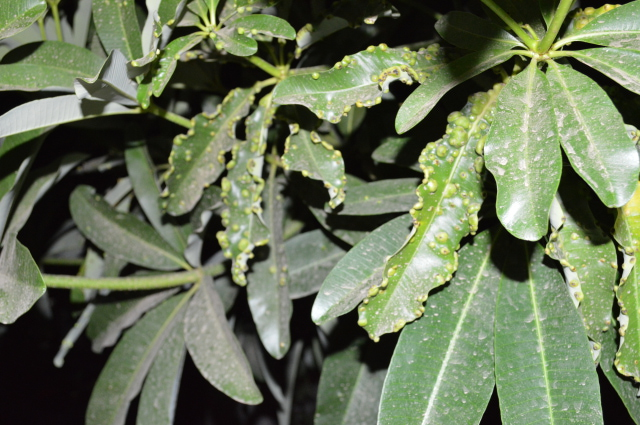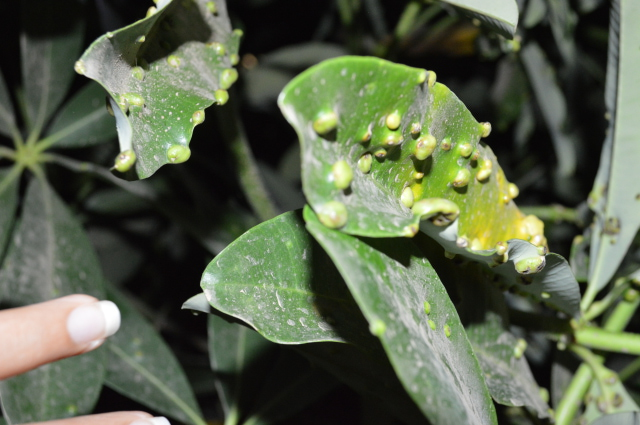Question Blisters on Alstonia S
Blisters on Alstonia S
 Blisters
Blisters
QUESTION: Background Detail: There are 5 'Saptaparni Trees' scientifically known as Alstonia Scholaris planted in front of my house. Three of them are quite young.
Problem: The leaves of the all the trees are having blister-like formations on it. Many of the leaves seem to have curled-up due to excess blisters on them. Its not only with the full grown leaves. A lot of baby leaves also have the same issue.
When I cut one of the blisters off a fallen leaf, there was a lot of blackish stuff in there.
Could you please tell me what is it and how to treat them and make my trees healthy again?
ANSWER: Dear Ketki, You have a very interesting problem. What you have is a type of nipple gall on your leaves. Nipple galls are formed by very tiny insects which lay eggs on the underside of the leaves. When the eggs hatch and the young start feeding, the leaf area around them starts growing very fast and abnormally. The reason for this is that it gives the young extra food to eat until they emerge from the gall to reproduce. In your particular case, these insects are probably a form of insect related to cicadas and leaf hoppers. Other leaf galls can be caused by aphids, and occasionally small wasps. Now getting rid of them is a little difficult. The problem is that the life cycle of all these insects is not well known, so it is very difficult to spray them when they are vulnerable. As long as they are inside the gall, spraying them has no effect. I do however have a solution. First, you need to pull off all the affected leaves. I know this will take some time, but it is absolutely necessary to get rid of these pests. Each gall could contain hundreds of these insects. Looking at your pictures, which are very helpful by the way, not all or even most of your leaves are affected. Pull off and destroy all these leaves. DO NOT use them in a compost pile or as mulch. Then after the leaves have been removed, I would spray the trees with NEEM. You should be able to find NEEM pretty easily, since the tree is native to India. I would spray every week for about a month, then you can probably drop back to spraying every month. If you find new leaves affected, pull them off too. The tree will replace the removed leaves on its own and will not suffer. I think that if you follow this remedy, you will be very successful, and by next year you will have no more problem. I hope this information helps you, and please write back if I ever may assist you in any way. Good luck, Melissa
---------- FOLLOW-UP ----------
QUESTION: Thanks a lot Melissa. I'd definitely give it a shot and start with the leaves first thing in the morning. However, I need to now how to make a Neem Solution. I have no idea how to spray neem, whatsoever.
Thanks, Ketki
AnswerDear Ketki, I'm not sure how best to explain this. I am fairly familiar with NEEM in India, but unfortunately I have not traveled there to see what actually is available. Neem is native to India, so it should be pretty easy to find. If you can find a pump-up sprayer to spray the chemical on the plants, that would be best. Then in that case you would simply mix a solution of NEEM and water if the Neem is in a liquid and put it in the sprayer and then spray. If it is in a powder, you would also mix with water, and if it is in a cake form, you would need to steep it in water until you have a tea-like mixture and spray with that. However, the main key here would be to remove the leaves with the galls on them. That will be your most effective control. The spray is really a secondary measure to try to stop the insects from entering the leaves. So try to spray if you can. Any method of getting a fine mist of chemical onto the leaves will work. You can even put the Neem in a spray bottle and spray that way. But the most important thing to do is to remove the leaves with galls. If you do that and only that, I still think you will be very successful and the leaves will be healthy by next year if you keep removing the affected leaves and destroying them. I hope this helps you. Write back if you have more questions. Melissa







